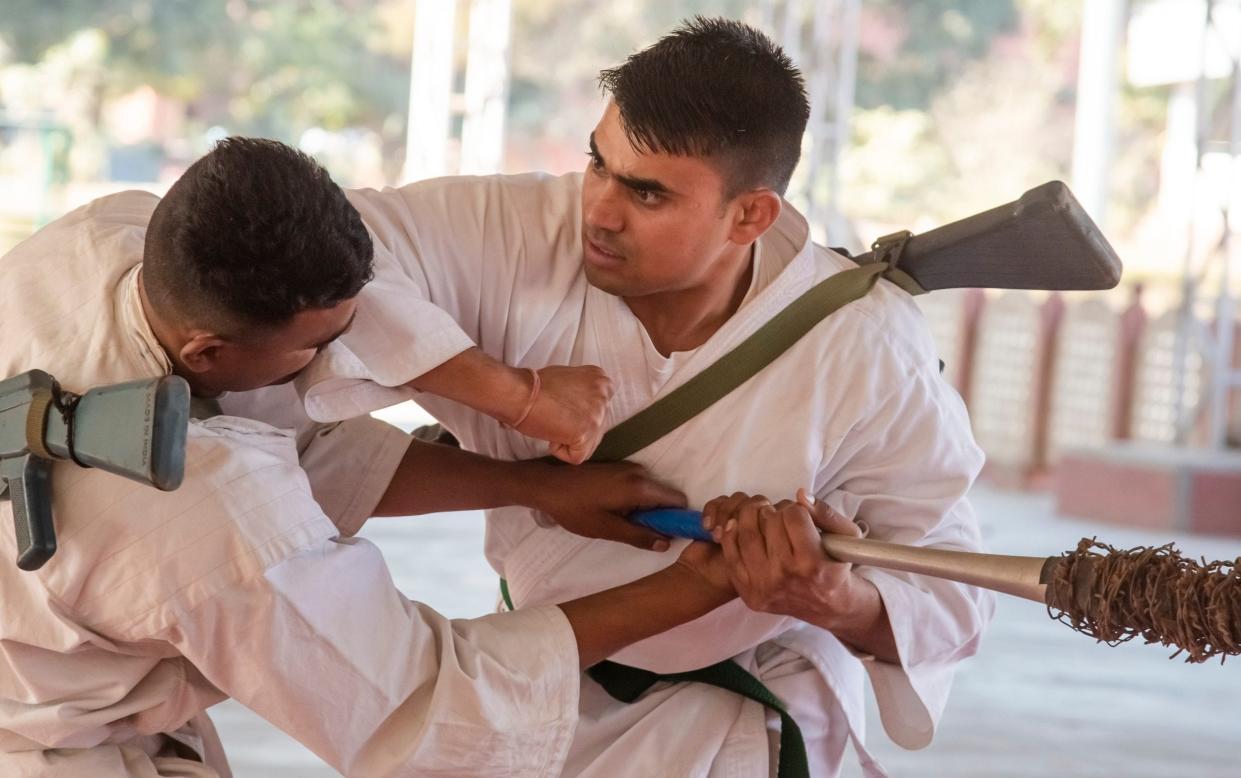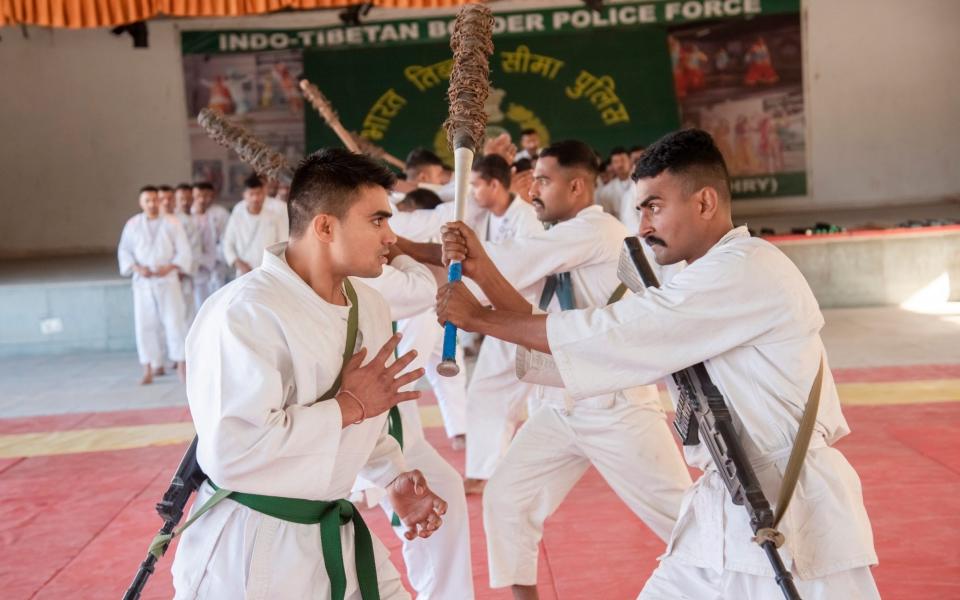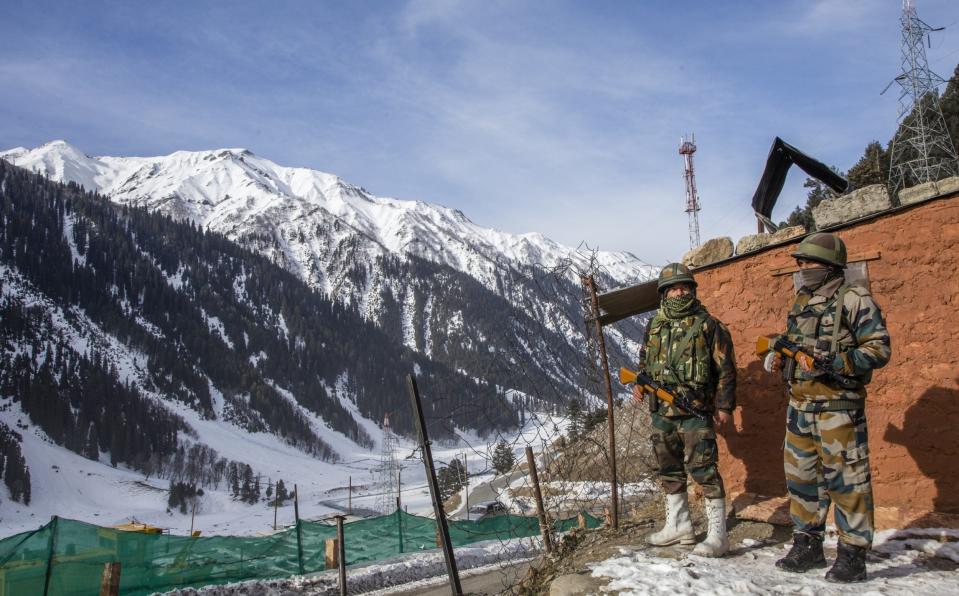India’s secret to fending off hordes of Chinese soldiers with nail-studded wooden clubs

When a bloodthirsty soldier approaches with a knife, hammer or, more likely, a club wound with barbed wire or pocked with nails, it is recommended to get as close as possible.
“You have to minimise the distance, block the attack and at the same time hit him on the face or neck with a free hand,” Rohit Spehia explains to his eager pupils.
Aim for the throat, eyes, ribs, collar bone and groin for maximum damage, he encourages.
“Then you will have to hold his neck under your free arm and hit him until he is incapacitated,” Mr Spehia concludes.
An officer with India’s Indo-Tibetan Border Police (ITBP), Mr Spehia is teaching his underlings, under the shadow of the Himalayas, the art of hand-to-hand combat that has become essential in patrolling the ugly frontier with China.
Last month Indian border units fought face-to-face with about 600 Chinese troops, leaving scores injured, some severely.
It came after two tense years of skirmishes along the disputed border that had left at least 20 Indian soldiers dead from injuries sustained by weapons including bamboo poles with nails and metal rods.
Nuclear-armed India and China have been at odds over their border since the 1962 war, but under a rules of engagement treaty their armed forces are not allowed to engage traditional firearms within two kilometres.
With bullets banned, soldiers are clubbed to death.
India’s answer is a crack team of 500 troops taught to speak Chinese, trained in 15 different Israeli and Japanese martial arts, and adept at defending themselves from whatever makeshift weapon comes their way.

“This special training emphasises aggression and simultaneous defensive and offensive manoeuvres so that our soldiers finish the fight as quickly and aggressively as possible,” Mr Spehia tells the Telegraph.
The fingers and knuckles of Mr Spehia’s pupils have become hardened like rocks from the rigorous program, which also includes punching into hot sand and water and commando training in the nearby dense jungle.
Near the platform of sparring soldiers in white, another group including women wearing khaki and army camouflage run drills along the training centre’s roads.
Some recruits are also learning Mandarin so that during “face-offs we can tell them that they have come into our territory and should go back,” said the senior ITBP officer.
After completing their 12-week training, the soldiers are ready to be posted for operational duties along the Line of Actual Control, the demilitarised border.
For Kuldeep Upadhyay, that moment can’t come soon enough.
“Hand-to-hand combat is a marathon, not a sprint,” the trainee soldier from Agra in Uttar Pradesh says.
“We started punching and kicking followed by countering knife and baseball bat attacks. Now, we are completely trained to tackle Chinese soldiers carrying nail-studded rods or clubs wrapped with barbed wire,” he adds.
He insists he is “excited” by the prospect of facing off against soldiers with makeshift weapons including knuckle dusters and rusted iron bars.
China and India last fought a war in 1962. It ended in humiliation for New Delhi and a steady truce was established.
On June 15 2020, soldiers from the Chinese People’s Liberation Army (PLA) overran the Galwan valley in the disputed region of Ladakh armed with nothing but clubs upgraded with nails or barbed wire.
At least 20 Indian and five Chinese soldiers were killed in the violent clashes that followed. China’s armed forces grabbed over 1,000 square kilometres of Indian territory in the freezing mountain range - all without firing a shot.
That incident turned what had been a broadly friendly relationship into a hostile one. The return of fighting in December has acted as the latest reminder for New Delhi.
India has since sent thousands of soldiers to the LAC, deployed tanks and heavy artillery, and is strengthening its border setup, from roads to communication networks.
“Infrastructure is being revamped, and we are ready to face any eventuality,” says a senior officer at the Haryana camp who asked not to be named.
The aim is to match China’s military buildup on the other side, which has accelerated since New Delhi in 2019 divided Indian administered-Kashmir into two new territories, including Ladakh, which Beijing claims is a disputed territory.
The challenge posed by Beijing is very different.
From building makeshift shelters on Indian land to sending shepherds into more remote areas, China has resorted to various methods to slowly shift the border.
Sometimes the Indian soldiers find chocolates or tea bags dropped by China’s PLA, in disputed areas.

“After we return to patrolling points, they lay their claim on the territory showing any signs of occupation, which then trigger frequent face-offs,” said the officer.
Indian officials say physical skirmishes along the border usually happen once or twice a month during summer when the weather is good.
But earlier this month, Indian Army Chief Gen Manoj Pande said there had been a slight increase in the number of Chinese troops along the border.
He said the situation was stable for now but remained “unpredictable”.
The PLA is also inducting fresh troops at the frontier with India, indicating that border tensions between the two countries are not over even as diplomats on both sides insist the border is calm.
Chinese president Xi Jinping on Wednesday held a rare video conversation with soldiers deployed along the India-China border in eastern Ladakh and inspected their combat readiness, reported Chinese state media on Friday.
Mr Xi spoke to the Xinjiang border command, a Chinese navy formation and an air force aviation brigade, asking them to “remain alert and be ready for combat”.
Back at the training camp a fresh-faced recruit faces an assailant armed with a nail-studded wooden club.
“Our territory! Go back!” the recruit shouts in Mandarin as he uses his arms to block a potentially fatal attack.
Without pausing, he strikes back, landing a volley of punches and kicks to his opponent’s groin and ribs.


